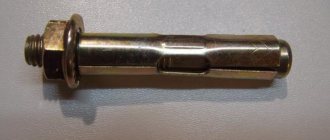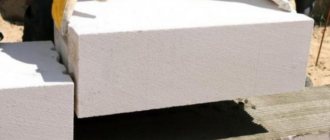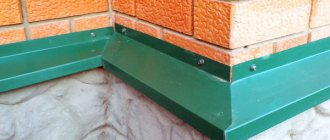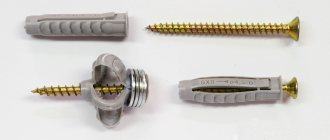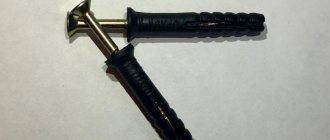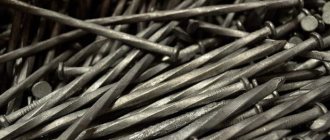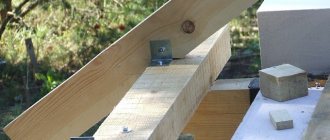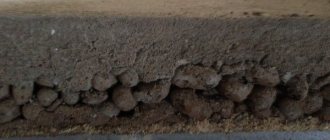Types and characteristics of fasteners
This group is divided into dowels with an expandable sleeve and telescopic ones, used in conjunction with self-tapping screws. The first type is the most common, the elongated wedging zone and the internal rod in this case pass through the slabs, plaster (if any) and go deeper into the walls or ceiling by 4.5 cm or more. The edge of the spacer rod is slightly pressed into the wide disc-shaped cap, thereby pressing the thermal insulation layer to the working plane. A striking example is TechnoNIKOL products - polymer tubular rods with a flange with a diameter of 50 mm are reliably fixed with deep-cut screws made of durable metal.
Based on the material of manufacture and design of the nail, there are polypropylene fasteners, metal and with a thermal head. The first group includes dowels with a wide perforated cap, expanded by a plastic rod, with a load-bearing load of no more than 380 N. They are used for light types of insulation, operated at temperatures from -40 ° C to +80 on vertical surfaces and facades with a solid base , their main advantages include low thermal conductivity (no more than 0.004 W/m °C), good adhesion to concrete, brick and foam blocks, corrosion resistance and affordable cost. But for high-density types or when planning to protect the insulation layer with heavy building materials, they are not suitable.
Fungi, pushed apart by an impact-resistant metal nail, with an average size of 10x100 mm and a head with a standard diameter of 60, can withstand a load of up to 750 N. They are selected when it is necessary to install them on the ceiling or decorate facades with heavy slabs of stone wool. In general, they are inferior to plastic varieties in corrosion resistance, but when using options with good quality metal coating, they last quite a long time. But due to differences in the coefficient of thermal conductivity with the insulation itself, they form cold bridges, which reduces the efficiency of external insulation; with an increase in the number of fasteners, this disadvantage becomes more pronounced.
Optimal characteristics in terms of resistance to corrosion, withstanding loads and eliminating heat loss are observed in dowels with a thermal head. In this case, the steel rod is covered with plastic, the products are not subject to external influences. The scope of application is almost universal and includes the installation of any thermal insulators to bases made of ordinary and lightweight concrete, brick, stone and wood; the inclination of the working surface does not matter. The only drawback is the high price.
What should you consider when choosing?
The consumption of fastening elements per 1 m2 depends on the type of structure, its height and location. On normal sections of the facade, 4-5 pieces are enough, on the corners - 6, when insulating the second floor of buildings - 7, in houses above 20 m - 9. In addition to the height, the thickness and density of thermal insulation, wind loads and the weight of future finishing are taken into account. The permissible maximum is 10 dowels per 1 m2; violating it is not recommended due to the risk of the formation of cold bridges and economic infeasibility.
When choosing an option for expanded polystyrene, preference is given to varieties with a cap that is rough on the inside. Attention is paid to the quality of anti-corrosion treatment; if there is a risk of precipitation penetrating inside or when insulating high-rise buildings, the most expensive types with a metal spacer element and a plastic thermal head are purchased. In addition to the load-bearing capacity, weight and dimensions, the characteristics taken into account include the operating temperature range; in northern latitudes, it is not recommended to use external insulation products with a plastic nail due to the risk of cracking. The layout and total quantity are thought out in advance, after choosing thermal insulation and calculating the thickness of the layer.
Types of fasteners
The shape of the product is determined by the specifics of the material being fixed: a light and loose heat insulator cannot withstand rigid fastening. The plastic pressure disk seems to support the insulation, but does not secure it.
However, the fasteners may differ in the design of the spacer part and the material of manufacture.
By design
There are 2 main fastening options.
- Non-expansion
- the dowel is not equipped with hardware and does not need it. The fastener is inserted into the drilled hole through the insulating material. In a wall or ceiling, the dowel is held in place by structural protrusions. - – in this case there is a nail or screw, which, when twisted or driven in, pushes the body of the rod apart. The latter is held in the wall material due to friction.
The spacer version is more often used when fastening into a dense material - concrete, while the non-spacer version is suitable for.
By material
To make the dowel, only plastic is used; if available, it can be made of plastic or metal.
- Polyamide
- or . Durable lightweight material suitable for installation on any surface: , . The maximum load can reach 120 kg, the working load, respectively, is 30 kg. - Polypropylene
– has higher strength and hardness, the maximum load can reach 150 kg. Working for dense material will be about 40 kg. - Glass fiber reinforced polyamide
is a relatively new material, not much inferior in strength to metal, but without its disadvantage - high thermal conductivity.
The spacer rod can be made of the same plastic, including reinforced plastic, as well as metal. The bearing capacity of the latter is higher, but they somewhat compromise thermal insulation.
Used:
- galvanized – with a zinc thickness of at least 6 microns;
- Stainless steel - fasteners are much more expensive, but absolutely resistant to corrosion. Used in rooms with high humidity.
Read below about the design of dowels for attaching insulation to the wall and other surfaces.
Structural design
This refers to a combination of materials. There are 3 options:
- the dowel and the nail are made of the same plastic. It is not recommended to combine different plastics, since each material is characterized by its own coefficient of thermal expansion;
- and a metal rod - the fastening strength is obviously higher and reaches 1.9 kN. However, metal conducts heat too well and forms a cold bridge in the heat-insulating layer;
- a plastic mushroom dowel for insulation and a metal rod with a thermal head - the nail head is covered with a nylon cap. The screw itself ends up inside the body of the rod. In this case, the problem of the cold bridge disappears.
Read below about the dimensions of the dowel-fungus for attaching insulation.
This video will tell you about the types of dowel-mushrooms for insulation:
Features of choosing dowels for insulation
Thermal insulation is a heterogeneous material and, as a rule, multi-layered. It is impossible to hold it by friction, as happens in dense material. In addition, when fastening, you need to worry about its integrity, especially in cases where the insulation is combined with waterproofing and vapor barrier.
This video will tell you about umbrella dowels for attaching facade insulation:
Design
The high complexity of the insulation, or, more precisely, the combination of the heat- and waterproofing layer, has given rise to 2 main types of fastening, which are divided into groups according to their purpose.
- dowel for facade thermal insulation and wall insulation;
- fasteners for roofing thermal insulation.
The first has a well-known appearance: because of the wide pressure disk, it is called a disc or mushroom. This design can be one-piece - actually a dowel with a head, or it can be collapsible. The latter consists of several elements:
- sleeve with spacer part. When fastening, the smooth non-expanding part ends up in the thickness of the insulation, and the expansion part ends up in the durable material of the wall or ceiling;
- the head in the form of a pressure disk is integral with the dowel;
- rod - when driven, it bursts the sleeve.
In fact, except for the large volume of the head, the dowel for insulation is no different from a regular one.
The disc diameter ranges from 45 to 90 mm. In some cases, an additional disk is put on the dowel - a rondole, with a diameter of up to 140 mm.
Dowel device for fastening insulation
Advantages and disadvantages
In the vast majority of cases, plastic fasteners are used.
- Firstly, the insulation is a light and loose material, and does not create a high load.
- Secondly, the metal rod, while increasing the strength of the connection, unfortunately, creates a cold bridge. The thermal conductivity of metal is much lower than plastic and it literally conducts cold through the insulation. To avoid this, steel nails for dowels with a thermally insulated head are produced.
The second type of dowel for roof insulation is telescopic. It is a hollow plastic rod with a wide pressure disk. It is mounted somewhat unusually: it is installed in the body of a heat insulator, or, more accurately, a roofing pie, and a nail or anchor passes through the rod and is immersed in a dense material - concrete, corrugated sheeting.
Selection factors
When choosing a product, you need to pay attention to a number of factors.
- The main one is sufficient length . It consists of the thickness of the thermal insulation and other layers, the thickness of the adhesive composition, the amount of deviation of the wall from the vertical and the minimum possible recess.
- Pull-out load - no matter how light the heat insulator is, it still has weight, and each fastener is designed for a certain load. In this case, it is necessary to take into account the working load, and not the maximum. Thus, the maximum load for a polypropylene dowel is 60–150 kg. However, the working level can only reach 25%, which equates to 15–37 kg.
Dowels for thermal insulation materials
When considering this type of product as a dowel for a facade, most people mean fasteners for thermal insulation. This option is much more extensive than the first; I will talk about each of the varieties in detail.
Fasteners for insulation to the facade are used for all sheet materials
Type 1 – dowels with plastic nail
This is the simplest solution; all the characteristic features of this type of product are presented in the table.
This is the most affordable product option
| Characteristic | Description |
| Material of manufacture | Polypropylene, polystyrene or nylon are used as raw materials. Both the nail and the dowel are made from the same material. When choosing, the main thing is to check the quality of the product; the element should bend slightly, but not be very hard, otherwise the spacer part will break when fastened |
| Diameter and length | Everything is simple with the diameter - it is always 10 mm. As for the length, it can range from 70 to 200 mm. I would like to add that you should not use dowels for thermal insulation longer than 160 mm. A plastic nail does not provide much rigidity, and if the element is too long, the fixation strength is greatly reduced |
| Spacer configuration | A very important aspect, since it is this part of the product that secures the mount. The length of the spacer section must be at least 50 mm. It is ideal if there are notches on the surface, which provide a more reliable fastening and prevent the fastening from being pulled out of the wall. The photo below shows exactly this option. |
Notches on the spacer prevent the fastener from moving in the hole
This type of product is excellent for lightweight thermal insulation materials:
- Styrofoam;
- Extruded polystyrene foam;
- Rolled mineral wool and sheet options of low density.
Facade dowels with a plastic nail are used only with light thermal insulation materials
The price per unit of product varies from 2 to 5 rubles depending on the manufacturer and length of the product.
I want to warn you against a common mistake. There is a misconception among buyers that orange or red dowels are better than white or black. But how can dye affect product quality? Be sure to check elements for elasticity and nails for rigidity, and do not rely solely on color.
Color doesn't matter, quality is much more important
Type 2 – dowels with metal nail
This option is the most popular
As for this type of product, its main features are as follows:
- The fixing part itself is no different from the option described above. The difference is in the nail, in this case it is made of steel and covered with a protective coating. Needless to say, this option is much more reliable and can be used for any type of insulation, be it polystyrene foam or heavy basalt wool;
Such dowels can withstand very heavy loads
- The length of the fasteners most often varies in the range from 90 to 260 mm, although if desired, fasteners longer than 300 mm can be found. Here the size does not matter much, since a nail with a diameter of more than 7 mm can withstand high loads without loss of strength;
Length may vary
- The simplest and cheapest options are a dowel and a metal nail with a small head. Their cost starts from 4 rubles and depends on the length of the product ;
This is the easiest option
- A better solution is nails with a thermal head. This is the name of the plastic spacer on the cap, which allows you to eliminate the appearance of stains from metal corrosion on the facade finish. The thermal head can be cast on the nail head directly at the factory, or it can be put on it immediately before fastening, there is not much difference. The cost of such options starts from 5 rubles.
Thermal head covers the metal and prevents it from rusting
Type 3 – composite dowels
This option is different from the ones described above
Composite dowels for attaching insulation to the wall appeared relatively recently, but are very popular for the following reasons:
- The spacer rod is made of fiberglass. This material is highly durable, it is not afraid of moisture and retains its strength for 50 years . The material is not afraid of temperature changes and retains strength under any conditions;
- Anchor elements can have a length of 60, 80 and 100 mm. The specific option is selected depending on the strength of the base and the length of the fastener;
- The pressure disk has a diameter of 60 mm. This is quite enough for working with dense materials;
- If the insulation is loose and easily deformed, then an expansion washer is placed on the pressure disk, which increases the diameter to 100 mm. You don't have to use it if it doesn't make sense;
The expansion washer is installed as needed
- This insulation fastening to the facade can have a length from 100 to 600 mm. This allows it to be used for any type of insulation;
- The cost of products starts from 5 rubles.
Recommendations for selection and installation
Now let's figure out how to choose the optimal size of dowels for thermal insulation and install them correctly.
The process is the same for all types, which is very convenient:
- First of all, you need to choose the optimal length of the fastener. Below is a table that contains all the most common sizes and indicates the drilling depth and the maximum thickness of insulation that can be used;
This table will help you choose the optimal dowel length in a minute
If you have walls made of fragile material, then add 20-30 mm to the length of the dowel for reliability.
- The amount of fasteners is calculated per square meter of area. There are two main mounting options, the first involves a consumption of 6 pieces per square, the second 4 pieces . The choice of a specific solution depends on the weight of the insulation; for polystyrene foam the second solution is also suitable; for mineral wool it is better to choose the first;
Decide in advance how you will attach the material.
- When preparing for work, pay attention to the facade of the building. All irregularities are eliminated, and cracks and damage are sealed with cement mortar. If you do not level the surface, then the insulation sheets will lie crooked;
- Before starting work, prepare everything you need. You will need a hammer drill with a drill of the appropriate length and diameter and a hammer for hammering in the fasteners. Below is a process diagram according to which we will work;
The instructions for carrying out the work are quite simple
- To begin, press the sheet where it is located. Make sure it sits flat on the surface. If there are problems, then you need to either level the wall or cut out part of the insulation to compensate for the unevenness;
The process of doing the work yourself is simple and clear
- Drilling holes is most often done directly through the insulation, since the material is pre-glued. Everything is simple here, the main thing is to control the horizontal position of the tool so that it does not turn out that the dowel becomes askew and one side sticks out above the surface. In order to control the depth, stick electrical tape or tape in a certain place on the drill;
The tool must be held level
- Take a dowel without a nail and carefully insert it into the hole until it stops. If you are unable to push the fasteners into place with your hands, use a hammer to help yourself. But you need to hit the plastic carefully; if you hit it too hard, it may break or bend ;
- Lastly, a nail is driven into the dowel. It should fit into the recess on the cap and not stick out above the surface.
After hammering a nail, the work can be considered successfully completed.
If you have a dowel with a fiberglass rod, then the work procedure will be even simpler. There is no point in describing it, everything is already clear from the diagram.
This is how fasteners made of composite materials are installed
Functionality of fasteners
A fungus for attaching insulation is often used in unfavorable environmental conditions. Therefore, both the plastic elements and the metal core must have special technical properties:
- mechanical strength;
- resistance to ultraviolet radiation and aggressive environments;
- withstand loads from the mass of the insulation, depending on its type and type of finishing;
- low degree of thermal conductivity;
- tolerate sudden changes in temperature;
- have high adhesion to the base surface material.
The strength of the dowel and the fungus itself must be such that when screwed or hammered into a hole in a wall, ceiling, or roof during their insulation, these elements do not collapse.
UV resistance is necessary when walls lined with insulation, secured with umbrella dowels, remain exposed to the sun for a long time. The products must also be well preserved in the plaster layer when facades are insulated using the wet method, that is, they must withstand an alkaline environment and not rust. Therefore, the core is made of galvanized steel.
Kinds
To put it simply, there are two main types of umbrellas.
Made from galvanized steel
The nail of such umbrellas in most cases is made of galvanized steel (sometimes polyamide). And although this material resists corrosion more than other metal ones, it is still not completely protected from it. There is a second drawback. Metal conducts heat well, which means that cold bridges can form at the attachment point and condensation can accumulate. Over time, cracks may appear at the attachment points. This type of fasteners has a higher cost.
Main characteristics:
- Dowel material: impact-resistant polypropylene.
- Anchor material: low carbon, galvanized steel;
- Temperature range: -55 - +60 degrees;
- Load: up to 750 kg per square meter.
As a conclusion: such fungi are used in the case of attaching heavy insulation, when the use of plastic is impossible.
Made of plastic
Dowel for thermal insulation with a plastic nail. They are used more often than metal ones, but they are less expensive and less durable. Although even their performance is quite impressive. The temperature ranges from -40 to + 80 degrees. Such umbrellas are also able to withstand loads from 20 to 380 kg per square meter. Nylon nails are also classified as plastic.
With thermal head
Thermal insulation dowels with thermal head are umbrellas with metal nails. A polymer head is placed on the end of the anchor. This approach is used for different types of walls, but is especially necessary for wooden ones. The purpose of the head is to reduce thermal conductivity. Such elements have a higher cost (the highest among dowels), but also the lowest thermal conductivity and strength.
In addition, fungi are distinguished by length. This is an important indicator that needs to be calculated correctly. The diameter of the rod for the anchor is also distinguished. Most often, rods with a diameter of 8-10 mm are used.
Disc-shaped dowels for fastening thermal insulation
To fasten thermal insulation made of expanded polystyrene, mineral or glass wool, special devices in the form of fungi (known as “umbrellas”, facade or disc dowels/nails) are used. The basis for reliable adhesion is the usual friction force; this fastener is used only once. As a result, the requirements for site preparation and installation are increasing. An important factor is the consumption of material and its dimensions (preliminary calculation is recommended); if a smaller number or unreasonably short parts are used, the thermal insulation will not hold up.
Distinctive features of the fungus are a wide cap and an expandable long leg, fixing the slabs in a vertical position when insulating walls or in a suspended state during roofing work. This is the only type of construction fasteners that goes completely deep into the facade. The dimensions of the core and sleeve of the fungus depend on the thickness and properties of the insulation (from 80 to 300 mm), the diameter of the cap is standard - 59. Spacer notches with sharp edges on the body contribute to the reliability of fastening; they face the plate and do not allow the dowel to come out of the wall. The quality of fixation is affected by the thoughtfulness of the holes on the cap (or roughness), which are literally pressed into the insulation.
Dowels with a disc head are suitable for many materials, regardless of their density and structure. Modern fungi for fastening insulation are not subject to corrosion and thermal influences, they are absolutely non-flammable. The raw materials are: for the head - low-density polyethylene (polypropylene), for the wedge - galvanized steel or polyamide. Wide nylon plates - rondoli - are sometimes used to attach soft insulation, but impact-resistant plastic is still preferable. The exception is installation and operation at abnormally low ambient temperatures, in which case polypropylene becomes brittle and breaks down.
Depending on the type of cap and material, fungi are distinguished with:
- plastic anchor;
- metal rod;
- thermal head.
The first ones are made entirely of polypropylene; a distinctive feature is the conical holes on the cap to improve the quality of adhesion. Such products have minimal thermal conductivity (≤0.004 W/m∙K), do not create “cold bridges”, can withstand temperatures from -40 to 80 °C and a load-bearing load of 20–380 kg/m2. Plastic anchor mushrooms are suitable for attaching lightweight insulation to concrete, brick and stone walls. The price is low, they are not subject to corrosion, but are of little use for installing heavy insulation.
Metal anchor mushrooms have a steel nail (galvanized or heat treated low carbon). The spacer elements and cap of this type are made of impact-resistant polypropylene, the sizes are slightly larger than the others. They cope with differences from -55 to 60 °C and load-bearing loads of up to 750 kg/m2. Disadvantages include the appearance of “cold bridges”; advantages include adhesion with heavy thermal insulation.
Dowels with a thermal head are worth buying for attaching insulation boards to a wooden wall. The end of the steel wedge is fitted with a small plastic part to reduce heat loss. Such fasteners can withstand loads of up to 920 kg/m2. Their cost is high (up to 30 rubles per piece), but this is compensated by minimal heat loss and chemical resistance.
To properly fasten the insulation with fungi, the following operations are performed sequentially:
- Calculation of length and consumption.
- Marking for future fasteners. Maximum permissible step: horizontally - 80 cm, vertically - 30.
- Preparing the seat: drilling holes in the insulation and the wall with a diameter of 10 mm to a depth that is 5–10 mm greater than the length of the fungus stem.
- Pressing in the dowel until the cap and insulation are completely joined. In this case, a hammer is not used; the work is carried out manually.
- Inserting a nail and driving it until it finally hits the wall.
- Closing the cap with a protective lid with fixation in the center.
When insulating walls, the old plaster is always removed; if this is not possible, the drilling depth is increased. In case of forced shortening of the fungus stem, the cut end must be sharpened. For brick and dense concrete, a length of 50 mm is enough; for loose or hollow building materials, it is better to buy fasteners of at least 100. The recommended depth of the hole for the fungus is checked with the sellers.
Anchor dowels
These dowels are used to secure the supporting brackets of the structure.
The first type of product used when working on the external walls of buildings is anchor dowels. They are used for fastening frames of ventilated facades. The structures are quite heavy. Therefore, high reliability requirements are placed on fastenings.
Let's figure out how to choose the best option:
This is what the simplest option looks like
- The dowel diameter starts from 10 mm and can be 16 mm for the most complex facade systems. The most commonly used options are 12 mm and 14 mm . It is very important that the material from which the dowel is made is not fragile, but not very soft either. When bent, the element should give in, but not break;
The quality of the plastic must be high
If the walls are made of aerated concrete or other fragile material, then you need to choose dowels with side lobes (builders call them “antennae”). They provide reliable fixation in the wall and do not rotate when tightened.
The antennae prevent the fasteners from turning
- The material used for making screws can be either regular or stainless steel. Very often, a layer of zinc or a high-strength anti-corrosion coating is applied to the surface to protect it from moisture. The minimum diameter used on facades is 8 mm; 10 and 12 mm options are also used. The greater the load, the thicker the screw;
Galvanized steel is most often used due to its low cost and reliability.
- The length of the fastener can be from 60 mm to 160 mm. It all depends on the strength of the wall. So, short fasteners will hold perfectly in concrete, but for foam concrete or cinder blocks it is better to choose a longer option . The thickness of the bracket is usually small, so this indicator is not particularly important.
Length can vary widely
Calculation of flow and length
When attaching insulation to 1 m2 of surface, from 4 to 10 products are required; for more accurate information, contact the supplier: each type of nail has its own size. It is not economically feasible to exceed the number of fungi; in addition, any additional hole reduces the overall thermal resistance of the house.
The length of the leg of a disc nail is determined as the sum of the thickness of the thermal insulation, adhesive composition, the size of the spacer part (minimum 40 mm, the value depends on the type and is specified in advance), and the deviation of the working surface from the vertical. Preliminary calculations should not be neglected; fungi for attaching insulation are cheapest to buy in bulk, but there is a risk of purchasing a large batch of unsuitable products.
| Name of fungus, purpose | Dimensions, mm | Maximum insulation thickness, mm | Minimum hole depth, mm | Price for 1 piece, rubles |
| Dowel with a propylene cap. For adhesion to stone and concrete | 10×80 | 50 | 40 | 3 |
| 10×110 | 60 | 55 | ||
| 10×180 | 130 | 60 | 5 | |
| Dowel with a galvanized steel rod for fastening polystyrene foam and layered insulation to concrete and brick bases. The connection is made by mechanical driving | 10×90 | 60 | 40 | |
| 10×120 | 70 | 55 | 6 | |
| 10×300 | 240 | 70 | 20 | |
| Mushroom dowel made of polypropylene with a metal thermal head, for attaching thermal insulation using the “wet facade” technology | 10×80 | 50 | 40 | 7 |
| 10×140 | 100 | 55 | 10 | |
| 10×220 | 160 | 70 | 15 |
How to calculate the number of dowels and their length?
Correct calculation of the length guarantees maximum fastening strength for the insulation. In the case of using plate mushrooms, the optimal size of the rod can be obtained using the following formula:
L = E + H + R + V.
The marking E refers to the length of the spread of the rod on the dowel. H – represents the thickness of the insulation. R is the thickness of the adhesive layer if the insulation is additionally glued to the surface. In turn, V determines the deviation from the vertical plane. The minimum thickness of the thrust is usually 45 millimeters or more.
Calculation of dowels for fastening insulation per m2 is carried out taking into account the weight of the thermal insulation. For example, for penoplex type insulation, only 4 fungi will be needed per 1 m2, while for basalt wool you will need 1.5 times more. The calculation formula is as follows:
W (quantity) = S (coverage area) * Q (number of dowels per square meter).
Don't forget about the reserve. At least 6 pieces of dowels should be on hand in case of loss or breakage of fasteners. When insulating corners, the number of dowel nails required increases. Thus, the “reserve” should be at least 12 pieces.
Facade construction polyethylene dowels are used for fixing heat-insulating boards when insulating structures whose walls are made of various materials, including brick and concrete of different grades. They are used in the installation of ventilated facades, insulation of “wet” plaster facades, and for high-quality installation of all kinds of insulation systems.
Consumption of dowels per m2 of facade insulation
1. The final (total) number of dowels is calculated for the area of the facade minus the area of window and door openings. The area of window and door openings is conventionally assumed to be 30% of the total area of the facade.
2. For ventilated facades, the bending load is not calculated. It is believed that the insulation is kept from “sliding” by the brackets of the subsystem.
3. The number of dowels is rounded up.
4. If the estimated quantity is less than 7 pcs. per square meter, it is recommended to install 7 pieces, since otherwise, to secure 1 thermal insulation board, the number of dowels will not be sufficient to prevent it from sagging.
Fungus sizes
The parameters of disc elements from different manufacturers may differ, since there is no single GOST that would regulate the size of such products.
You can only specify general values:
- the diameter of the mushroom cap for attaching the insulation varies from 45 to 90 mm;
- the diameter of the rod can be 8 or 10 mm;
- length range is 40-400 mm.
Dowels are available in different sizes
Depending on the size, wedge material and wall material, the load on the fungus can range from 0.3 to 23 kN.
How to correctly calculate the length of the fungus for insulation
In most cases, to determine the required length, approximately the following formula is used:
Let's look at the symbols. They look like this:
- E
is, of course, the required dowel length; - A
– the thickness of the insulation material itself; - B
- this includes the thickness of the previous plaster, as well as glue; - C
– depth of penetration into the working surface (wall), which should be at least 45 millimeters; - D
is the approximate margin that is necessary for minor deviations of the working surface plane.
Although if you do everything “by eye”, the procedure will look even simpler: 40-45 millimeters are added to the thickness of the thermal insulation material for the recess, then another 10 millimeters for the remaining layers of the pie. For example, the thickness of the insulator is on average 50 millimeters, which means - if you make simple calculations - it will require a fungus 105 millimeters or 10.5 centimeters long.
Installation
The installation of thermal insulation using disc dowels is a very simple process. It consists of a list of the following works:
- Marking the area for installation.
- Drilling holes at right angles for fastening together with thermal insulation.
- Installation until the disc fungus is completely adjacent to the insulation.
- Driving a nail for expansion and final fastening.
- Attaching a nail-protecting cap.
Before fixing the thermal insulation, you need to either remove the old layer of plaster or increase the drilling depth. For ease of use, the heat-insulating material is first glued to the walls with a special adhesive, allowed to dry, and only then the dowels are installed.
The hole for fastening is made 8 - 10 mm wide. The depth should be 60 mm for a 50 mm anchor component, and 110 mm for this 100 mm component.
After attaching the thermal insulation material, there remain fairly deep holes that need to be sealed using a paint spatula. To do this, you can use the same solution as for gluing the insulation.
Advice . If you decide to reduce the length of the spacer, be sure to sharpen the truncated end.
Today, the dowel for thermal insulation is the main fastening system offered on the building materials market. The leading manufacturers in this area are Russian, Polish and German enterprises. To ensure high-quality insulation of your home, it is better to purchase products from these countries.
Options
There is no GOST article regulating plastic dowels for insulation.
However, the requirements for polyamide material for construction dowels apply, and GOST specifies exactly what brand of plastic can be used and for what climatic zones.
The fasteners are distinguished by their long length: after all, the dowel must go deep into the wall through a rather large layer of thermal insulation.
The remaining sizes vary very little:
- the size of the cap ranges from 45 to 90 mm in diameter;
- on plastic there are only 2 rod diameters - 8 and 10 mm;
- The length of the product ranges from 40 to 400 mm.
The load-bearing capacity depends on the strength of the fasteners and the wall material. The load ranges from 0.3 kN to 23 kN.
| Dimensions of plastic fasteners, mm | Weight 1000 pcs, kg | Dimensions of fasteners with metal screws, mm | Weight 1000 pcs, kg |
| 10*80 | 2 | 10*90 | 15 |
| 10*90 | 2,5 | 10*120 | 16,75 |
| 10*100 | 6 | 10*140 | 20 |
| 10*120 | 8 | 10*160 | 32,2 |
| 10*140 | 9,8 | 10*180 | 44,5 |
| 10*160 | 11, 25 | 10*200 | 57,5 |
| 10*180 | 13,8 | 10*220 | 62 |
| 10*200 | 14,5 | 10*260 | 81,3 |
| 10*300 | 105,5 |
Read below about fastening insulation boards with disc dowels.
Nuances of installing thermal insulation
The fungi for fastening the slabs are fixed after preparing the base and gluing the material itself to it. Work is carried out in the following sequence:
- On the surface of the foam plastic or mineral wool, the location points of future fasteners are marked with a recommended interval of no more than 80 cm horizontally, 30 cm vertically. When thermally insulating bases with a complex shape or using separate pieces, it is worth drawing up a layout of dowels in advance.
- A mounting hole with a diameter of no more than 10 mm is prepared in the insulation and walls.
- The mushroom is placed manually until the cap is completely pressed against the insulation.
- The spacer element is installed inward until the maximum stop is reached.
- Closing the cap with plastic (for varieties with a thermal head).
Upon completion of the installation of all dowels, the joints are sealed, a vapor barrier, reinforcing mesh and external finishing are placed. The work is carried out after the adhesive composition has dried, this takes 2-3 days. If it is necessary to attach to wood or metal, specialized options are used together with a plastic pressure collar; the installation process in this case is almost indistinguishable.
Important nuances of the technology include selecting the correct length of products and calculating their required consumption per 1 m2. The design is considered reliable when the spacer sleeve is deepened into the base by at least 4.5 cm; when working with porous or weak materials, it is recommended to increase this norm to 10 cm.
Shedding plaster or similar peelable types of cladding negatively affect the quality of fasteners; when carrying out insulation, it is unacceptable to skip surface preparation. The recommended margin is 1-2 cm, it is better to err on the larger side.
Prices
| Brand | The basis | D washer, mm | Fastening sizes, mm | Housing materials | Nail | Price, rubles |
| Mushroom plug for Tech-Krep insulation | Concrete, stone, brick, gas silicate | 60 | 10×100 | Polypropylene | 2,5 | |
| Same with thermal head | 16×100 | Polypropylene | White zinc coated steel | 9 | ||
| With a metal nail | 12×100 | 5,6 | ||||
| Koelner with metal nail and thermal head | 10×200 | Yellow zinc coated steel | 14 | |||
| Booster cuff Rondol | Tree | 50 | — | — | 1,5 | |
| TechnoNIKOL telescopic fastener with self-tapping screw | Load-bearing roof base: corrugated sheet, concrete, wood | 10×200 | High-strength polymer | Used with Technonikol metal screws | 8,2 | |
The cost of dowels for thermal insulation depends on the advancement of the brand, the quality of the material and the dimensions: the length of the sleeve and spacer and the diameter of the washer. Products with a metal nail cost twice as much as polypropylene ones; fasteners with thermal heads are even more expensive. Saving is not recommended, this affects the reliability of fixation; the only way to reduce costs is to purchase in bulk.
Installation
The fastening features are determined by the characteristics of the material. Thermal insulation is in most cases used in the form of panels or sheets. Such material is fixed according to the rules, which should be taken into account both during calculations and during insulation.
Read below about the consumption of dowels per 1 m2 of insulation.
Calculation of dowels
The peculiarity of the calculations is that the bearing load here is not decisive. The weight of the insulation turns out to be less important compared to its thickness and looseness, as well as compared to the nature of the wall or ceiling. The product data sheet, of course, indicates the pullout load, but in practice it is taken into account when choosing the appropriate length of the product.
- Length is an extremely important characteristic, since it includes several quantities: the thickness of the insulation, the thickness of the adhesive layer or the vapor and waterproofing layer, or all together, the amount of deviation from the vertical and the minimum permissible amount of penetration into the material. Moreover, the latter is indicated for each material - dense concrete, cellular, hollow brick, and so on. All these parameters must be indicated in the certificate, and you need to pay close attention to them.
- Cap diameter - here the recommendations are more approximate: the more loose, lightweight material is used, the larger the cap diameter should be. For foam plastic, for example, you can choose products with minimal heads. To attach mineral wool to the ceiling you will need large disks.
- The number of dowels is determined not so much by the weight of the insulation as by holding 5 fasteners: 4 in the corners, 1 in the center.
- If the insulation is installed on a facade, where wind load , there should be more fastenings. At the corners of the building, the panel is fixed with at least 6 dowels - arranged in two parallel rows, with a building height of up to 20 m, the panels are fixed at the rate of 7 pieces. per 1 sq. m - located in two rows and 1 in the center. If the building is higher than 20 m, then the insulation is fixed at the rate of 9 pieces. per 1 sq. m.
Technology
The heat insulator is fixed at an intermediate stage of installation. Some of its complexity lies in the fact that all the nuances of fastening must be taken into account in advance. For example, if the ceiling to which the dowel will later be attached is covered with plaster, it is necessary to increase the length of the penetration, especially if the plaster is not new, or remove it altogether.
- The insulation is fixed to the surface using glue - polystyrene foam, polyurethane foam, or spaced into frame cells - mineral wool.
- Mounting points are marked on the panels. Then drill holes for fasteners directly through the insulation. The depth of the hole in the base surface should be 10–15 mm greater than the calculated one.
- Unlike usual cases, there is no way to clean the hole here. And if the dowel does not penetrate the material to a sufficient depth, it will not even hold the heat insulator.
- The dowel is inserted into the hole, the disc head should press the material somewhat.
- Then, if there is one, a spacer nail is driven into the dowel. The nail head is covered with a cap if nails with thermal heads are used.
It is preferable to choose joints for fastening, thereby reducing the total number of cracks and holes. In addition, especially during facade work, it is recommended to glue the joints with aluminum reinforcing tape after installation.
Prices for a disc dowel (mushroom, fungus, nail) for attaching insulation are given below.
Dowel nails for thermal insulation
Price for labor and materials
Thermal insulation is an essential part of construction and most renovation work. So the need for disc dowels for thermal insulation is always high and does not depend on the season. Many well-known companies produce products.
- Fischer - it is probably impossible to name a fastener that is not produced by this German company. Plastic dowels will cost 10–11 rubles. per piece Fasteners made of nylon sleeve and nails made of galvanized yellow-passivated steel - 13–37 rubles. per piece
- Mungo all possible types of fasteners, including disc dowels. The plastic version costs from 6.6 to 14.3 rubles. per piece, option with a galvanized steel rod - from 9.8 to 18 rubles. per piece
- Koelner, a well-known Polish manufacturer on the Russian market, produces various types of fasteners for thermal insulation. Plastic fasteners for facade thermal insulation cost from 12 to 15 rubles. per piece The option for roofing thermal insulation is telescopic, it will cost 10–13 rubles. per piece
- Tech-KREP is a Russian company offering fasteners for hollow and solid materials. A disc-shaped dowel made of polyamide with a basalt-plastic rod costs from 8.8 to 14 rubles. per piece
The dowel for thermal insulation is an indispensable participant in the work of insulating a building. The fasteners are very easy to use, do not create a load and provide reliable fixation of the thermal insulation of the material.
The video below will tell you how to properly attach thermal insulation to walls using dowels:
Did you like the article? Share with friends on social networks:
And subscribe to site updates in Contact, Odnoklassniki, Facebook, Google Plus or Twitter.
Prices
The cost of disc dowels (if we talk about Moscow and the Moscow region) is at least 1.5 rubles per unit.
You can save a little money by ordering in bulk. There is another way to reduce the final cost - for example, pickup.
Table. Average market prices for umbrellas
| Type of umbrellas | Plastic anchor | Iron anchor | Iron anchor and thermal head |
| Cost, in rubles per unit | 5,10 | 4 | 1,50 |
Tips for use
When choosing disc dowels, you should pay attention to some nuances:
- if penoplex is being installed, then the choice should be made on varieties with a rough cap;
- It is worth paying increased attention to the quality of anti-corrosion treatment if there is a risk of precipitation getting inside the thermal insulation structure;
- when insulating high-rise buildings, you should purchase the most expensive models of disc dowels with a metal spacer nail and a plastic thermal head, which protects the structure from moisture getting inside;
- to the preferred operational characteristics, in addition to maintaining the total mass of the structure, its own weight and dimensions, the temperature range of operation should also be added;
- in northern latitudes under extreme weather conditions, it is undesirable to use a plastic disc dowel with a plastic spacer rod in the installation of external insulation. The fact is that at extremely low temperatures and changes in humidity, there is a serious risk of cracking and subsequent destruction of the entire thermal insulation system. In such a situation, preference should be given to a disc dowel with a metal rod and a thermal cover or a façade disc dowel with a fiberglass rod.
Length calculation
If the fastening element is chosen incorrectly, it will not hold the thermal insulation. And you will have to tear it off along with the attached sheets. How not to make a mistake and calculate the required length right away?
The purpose of the dowel is to secure the insulation to the main wall. This is where you need to get to. On the way to a solid surface lie:
- The insulation itself;
- Thickness of the adhesive (if any).
In addition, it is worth considering that the dowel must go into the wall to a depth of 50 mm.
Thus, we calculate the required length using the formula:
L = H + I + K + W.
L – required final dowel length;
H – thickness of the heat-insulating layer;
K is the thickness of the old plaster or adhesive to which the insulation is attached;
I – fastening the dowel into the concrete/brick/wooden base of the wall (at least) 50 mm.
W – margin for wall curvature.
For example, if you use foam plastic with a thickness of 50 mm and use a thin layer of glue - 5-10 mm, a dowel 110 mm long will be enough for you. If the wall is smooth. But, if the wall distortion reaches 50 mm, it is worth adding this figure and then you will need a dowel of 160 mm or more. If we increase the thermal insulation layer to 100 mm, in the latter case we will need 210 mm of rod length.
When choosing fasteners: longer does not always mean better. If insulation occurs, for example, in an apartment, the thickness of the walls may be especially small and you need to correctly calculate the length.
Installation of insulation using special mushrooms
Now let’s figure out how the insulation procedure generally occurs using such fastening elements. Let’s say right away that there is nothing complicated about this, so you can easily do the job yourself. Below are the main steps of this procedure.
Stage one. First you need to prepare the base.
Stage two. Next, the insulation material is glued onto a special solution.
Stage three. Then the fastening is carried out, for which the already known disc-shaped dowels are used (this is also called a fungus for attaching insulation).
Stage four. All joints are carefully sealed.
Stage five. A hydro- and vapor barrier layer is installed.
Stage six. The surface is plastered using a fiberglass reinforcing mesh (if necessary, of course).
Stage seven. At the end the final finishing is done.
Let us consider in more detail the technical aspects of the insulation procedure.
First you need to prepare the surface. To do this, the previous plaster is cleaned off, all depressions and bulges are eliminated to create a smooth surface. Then the insulation is attached to the working surface using a special adhesive mixture. If the surface is fairly smooth, you can use a notched trowel for application; although in most cases the mixture is simply thrown onto the slabs in small piles.
So that the first row does not fall under the weight of the subsequent ones, a so-called starting bar is attached to the lower part (you can make it from a metal profile or lath), where the sheets will rest. Then, when the glue is completely dry (usually this takes two to three days), the sheets are finally secured with the described fungi. First, holes are made in appropriate places using a hammer drill. It is important that the drill used is the same thickness as the stem of the fungus.
The depth of each hole should be about 0.5-0.7 centimeters so that the fungus is completely clogged there, regardless of whether there is installation dust there. The number of dowels for one insulation board depends on the height of the ceilings and their (slabs) location.
- If we are talking about an ordinary area, then it should be fixed at the rate of five fungi for every square meter.
- In the case of corner plots, this number can be increased to six.
- If the height of the room varies between 8-20 m, then the number of umbrellas will be seven per square.
- Finally, if the ceiling height exceeds 20 m, then one square of insulation is attached in 9 places.
It is advisable that the fastening points be located at the joints of the sheets - this way you will be able to avoid the formation of additional holes “for ventilation”, moreover, after installation the edges of the plates will not be bent. In the image below you can see what several common fastening methods look like.
Note! If the insulation sheets should be attached to a surface made of metal or to corrugated sheets, then first insert a self-tapping screw into the dish-shaped part, and then screw it all on using a screwdriver.
Next, the insulation is pressed with a fungus to the very base. The screw is screwed into the metal so that the cap fits as tightly as possible to the thermal insulation material. It is important that the self-tapping screw goes at least 1.5 centimeters into the base.
More detailed instructions are shown in the image below.
Then all joints are carefully sealed using thermo-retractable metallized tape. If there are gaps of more than 0.5 centimeters remaining, they can be blown out using polyurethane foam. Although this should be done with extreme care, since some types of foam can corrode the polymer heat insulator.
If you plan to build a ventilated facade, then the mineral wool must be covered on top with a special membrane for hydro- and vapor barrier. Although there are exceptions - insulation materials that do not absorb moisture well (foam, for example, or polyurethane foam).
During plastering, the surface is covered with a 3 mm layer of adhesive, which will serve as protection. The composition should be applied evenly, so it is preferable to use a notched trowel for this. Next, a mesh reinforcement made of fiberglass is pressed into this layer, while maintaining an overlap of ten centimeters. To finally level the working surface for finishing, the walls should be treated with another layer of mortar and leveled using a long rule. The video below demonstrates how thermal insulation material is installed if a fungus is used to attach the insulation.
Video - Installation of insulation using umbrellas, 4 cm
Video - Thermofix Fischer thermal insulation dowel
As a small conclusion
If you are planning to insulate your home, then be sure to adhere to the technology, which means it is strictly not recommended to save on fasteners. Otherwise, they will not be able to withstand the mass of plaster and will collapse along with the entire thermal insulation “pie”. This especially applies to corner areas, because they are known to be loaded the most during strong wind gusts.
Sources
- https://stroitel-lab.ru/obzor-gribkov-dlya-montazha-uteplitelya.html
- https://stroyres.net/metallicheskie/metizyi/dyubel/dlya-uteplitelya.html
- https://ZnatokTepla.ru/utepliteli/gribki-i-dyubeli-dlya-krepleniya-uteplitelya.html
- https://vtekb.ru/zabor/rashod-dyubelej-na-m2-utepleniya-fasada.html
- https://1pofasady.ru/uteplenie/gribki-dlya-krepleniya-uteplitelya
- https://izollab.ru/spravochnik-materialov/dubel-dlya-teploizolyacii/
- https://v-teplo.ru/gribki-dlya-krepleniya-uteplitelya.html
- https://stroy-podskazka.ru/dom/uteplenie/dyubeli-dlya-teploizolyacii/
Installation technology
Whatever insulation you use, be it polystyrene foam, polystyrene foam or penoplex, the technology for installing the material using dowels will be identical. First, the thermal insulation is prepared, then the panels are installed using an adhesive solution, and at the next stage they are fixed with dowels. We should not forget about the need to process the joints, as well as install an insulating film. At the final stage of thermal insulation, it is sheathed with finishing material or plastered. Before installing the insulation, it is important to prepare the surface, remove the plaster and repair uneven areas and cracks. In order to improve the adhesive properties of the glue, the base of the walls is degreased. Panels of polystyrene foam, polystyrene foam or penoplex are seated on an adhesive composition, which should not contain toluene or acetone, as well as other organic solvents. In order to prevent the thermal insulation from shifting under its own weight, a metal profile must be laid under the first row of slabs. Once the solution has dried, additional fixation with fungi can be carried out. To install them, you will need holes, for making which you should use drills with a diameter equal to the diameter of the fastener leg. While the length of the hole should be one centimeter longer than the length of the dowel, this will prevent unreliable fixation if dust has accumulated inside the hole.
